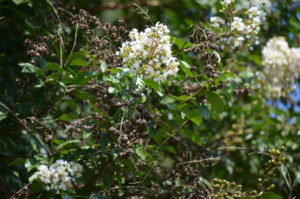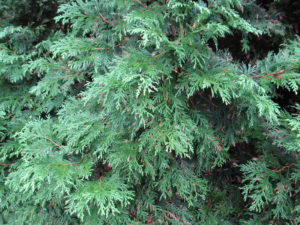Some large shrubs can be trained into lovely small flowering trees. These three flowering shrubs may be trained into small 15-25 feet tall, single or multi- trunk trees:
Siebold viburnum (Viburnum sieboldii) is a tall upright branched deciduous shrub (USDA hardiness zones 4-7). This native from Japan grows to 15-20 feet tall and 10-15 feet wide within 10-12 years.
In mid to late May, showy white flat-topped flowers appear in abundance, measuring 3-4 inches across. Flower heads are composed of small sterile center flowers surrounded by larger white fertile flowers. Flowers give way to ½ inch wide red berry-like fruits (drupes) on showy red fruiting stems in late summer; they ripen to black in fall and attract winter feeding birds. The 3-inch long, medium to dark green leaves has no memorable fall color.
Panicle hydrangea (Hydrangea paniculata) also originates from Japan and China and is exceptionally cold hardy (USDA hardiness zones 3-8). Depending on cultivar, this vigorous grower reaches 8-15 feet tall as a shrub and to 25 feet tall as a lovely patio tree. From mid-summer into fall, huge 6-8 inch long, creamy white terminal flower panicles contain both fertile and sterile flowers. Its dark green, blemish-free ovate foliage is coarse textured. Select tall growing cultivars like ‘Limelight’ or ‘Grandiflora’ to transform into trees.
Diabolo ninebark (Physocarpus opulifolius var. Diabolo) is an upright, spreading, deciduous, shrub (Zone: 3 to 7). ‘Diabolo’ is a purple-leaved cultivar that grows 6-8 feet as a shrub and 12-15 feet tall in tree form. It is easily identified for its exfoliating bark on older branch and trunk wood which peels off in thin strips to reveal the reddish to light brown inner bark. This heightens its winter interest. Small pink or white flower heads, resembling flowering spireas (they’re related), appear in late spring. Flowers give way to drooping clusters of reddish seed capsules. The 3-5 lobed, 4-inch long ovate leaves start out dark purple and bleach out to dark green in the heat of summer, and turn a blah yellow in fall.
All three landscape shrubs grow well in average, mildly acidic (pH 5.5 to 7.0), moderately moist, well-drained soils and in full to partial sun. All three are relatively drought tolerant after their first year. Prune siebold viburnum and ninebark immediately after spring flowering. Wait until late winter to prune panicle hydrangea. No serious insect or disease problems are attributed to these shrubs when they are properly sited in the landscape.




















